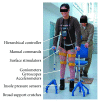Neural Prosthetics:A Review of Empirical vs. Systems Engineering Strategies
- PMID: 30532801
- PMCID: PMC6247642
- DOI: 10.1155/2018/1435030
Neural Prosthetics:A Review of Empirical vs. Systems Engineering Strategies
Abstract
Implantable electrical interfaces with the nervous system were first enabled by cardiac pacemaker technology over 50 years ago and have since diverged into almost all of the physiological functions controlled by the nervous system. There have been a few major clinical and commercial successes, many contentious claims, and some outright failures. These tend to be reviewed within each clinical subspecialty, obscuring the many commonalities of neural control, biophysics, interface materials, electronic technologies, and medical device regulation that they share. This review cites a selection of foundational and recent journal articles and reviews for all major applications of neural prosthetic interfaces in clinical use, trials, or development. The hard-won knowledge and experience across all of these fields can now be amalgamated and distilled into more systematic processes for development of clinical products instead of the often empirical (trial and error) approaches to date. These include a frank assessment of a specific clinical problem, the state of its underlying science, the identification of feasible targets, the availability of suitable technologies, and the path to regulatory and reimbursement approval. Increasing commercial interest and investment facilitates this systematic approach, but it also motivates projects and products whose claims are dubious.
Figures





References
-
- Grill W. M. Nerve Stimulation. John Wiley & Sons, Inc.; 2006. (Wiley Encyclopedia of Biomedical Engineering). - DOI
-
- Grill W. M. Electrical stimulation of the central nervous system. In: Bronzino J. D., editor. The Biomedical Engineering Handbook. Boca Raton, FL, USA: Taylor & Francis; 2006. pp. 30-1–30-15.
-
- Loeb G. E. Neuroprosthetic Interfaces–The Reality behind Bionics and Cyborgs. Human Nature and Self-Design Paderborn. Germany: Mentis Verlag GmbH; 2011.
Publication types
LinkOut - more resources
Full Text Sources

